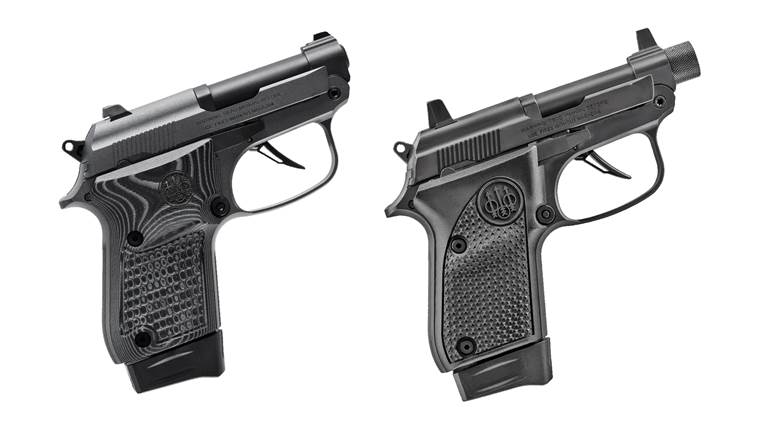
3,000 RPM on a bicycle! In September 2013, Sebastiaan Bowier set the flat-surface bicycle speed record at 83.13 miles per hour. That's some serious pedal pushing.
I'm not sure who mounted a Villar Perosa M1915 machine gun on a bicycle, or when, or even why they did it. What I am sure of is that it has to be the greatest amount of firepower ever mounted aboard a bike. Regardless of how fast the cyclist can pedal, the Villar Perosa spits out 9 mm Glisenti ammo at up to 1,500 rounds per minute. Even I can do the math, and with its twin barrels, the little Italian dynamo rattles out up to 3,000 rounds per minute. Mama Mia, that’s 50 rounds per second!
The most common configuration of the M1915 Villar Perosa, equipped with a lightweight, folding bipod.
With just 25 rounds in each top-mounted magazine, the firer will only get a one-second squeeze on each of the thumb-button triggers on the Villar Perosa's spade-grips. I have no data on speed-reloading Villar Perosa magazines while in the act of pedaling, but you'd likely get quite a workout riding back and forth from the ammunition dealer. 
M1915 Villar Perosa on its transit case. Note the rear sight, built into the spade grips.
A relative unknown: The strange little M1915 Villar Perosa was the first true submachine gun in action during World War I. No one seemed to consider it a “subgun” though, and to be fair, no one really knew the category even existed at that time. Featuring the side-by-side coupling of identical guns, the Villar Perosa was usually operated as the world's lightest crew-served weapon. The twin-gun arrangement weighs just slightly more than 14 lbs., with the occasional addition of an armored shield weighing far more than the weapon itself.
Troops firing the Villar Perosa though its weighty shield.
The “crew-served” description comes from the necessity to have several men focused on reloading the rapid-firing little weapon. I suspect that overheating would have been a significant problem during any extending firing. Various mounts were used, all seemingly more awkward than the next, this including an unconscionable shoulder-stock arrangement that kept the spade grips and the thumb-button triggers. Villar Perosa fires from an open bolt, on full-automatic only. Magazines are inserted from the top, and spent casings are ejected from the bottom. The sights are rudimentary: the rear sight is built into the spade grips, while the front sight is integrated into the front plate that joins the two barrels. 
Austro-Hungarian troops with captured M1915 Villar Perosa SMGs. Note the lightweight tripod and metal baseplate.
Some attempts were made to mount the Villar Perosa on aircraft (as an observer’s weapon, and also placed on the upper wing for the pilot to use), but the 9 mm Glisenti rounds proved to be far too weak, lacking the range and penetrative power for air-to-air work. With all things considered, the bike mount makes as much sense as most wartime mountings for the M1915 Villar Perosa. Plus it is a helluva’ lot more manly than your average bicycle bell.
The M1915 Villar Perosa shown without the top-loading magazines. Note the centrally-mounted sights.
A design pointing to the future: Despite the Italians’ struggles to find a strong tactical application for their incredible little bullet-sprayer, the battlefield potential of the M1915 Villar Perosa was clear. The lightweight bipod and tripod mounts were most useful for the Alpini, Italy’s mountain troops that spent most of the Great War fighting the Austro-Hungarian forces in the Alps. The Villar Perosa’s suppressive fire capability was unmatched at that time. Sustained fire however, was a completely different story.
Austro-Hungarian troops with machine guns captured from the Italians: the French St Etienne Mle 1907 (left rear), the Vickers Mark I (right rear), the Lewis Mark II and the M1915 Villar Perosa.
During 1918, the twin barrels of the M1915 Villar Perosa were split up. The new OVP M1918 was redesigned as an automatic carbine, retaining the top-mounted magazine, and using new offset sights. Berretta also got involved, and adapted the Villar Perosa design to create its Model 1918 (the cyclic rate was brought down to a more manageable 900 rounds per minute). This was one of the world’s first conventional submachine guns. Of course, Berretta would go on to design many more SMGs, creating some of the best submachine guns of all time. Against this backdrop, the Villar Perosa would quietly fade into full-auto obscurity.
M1915 Villar Perosa showing details of its transit case: multiple 25-round magazines, and cleaning kit.





































